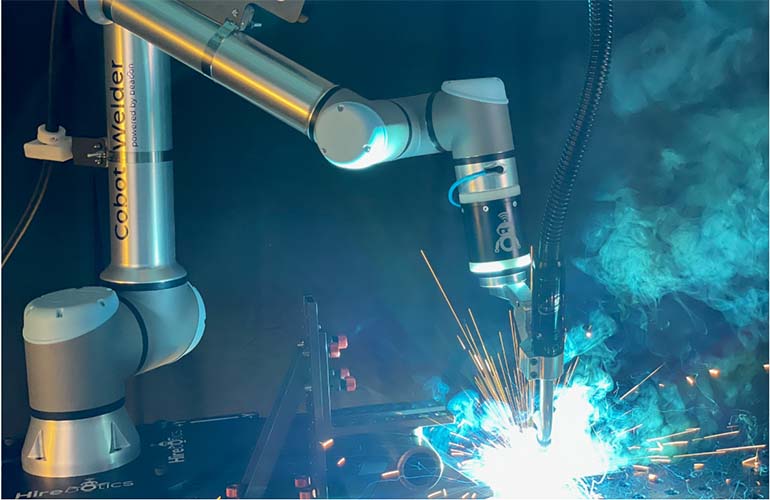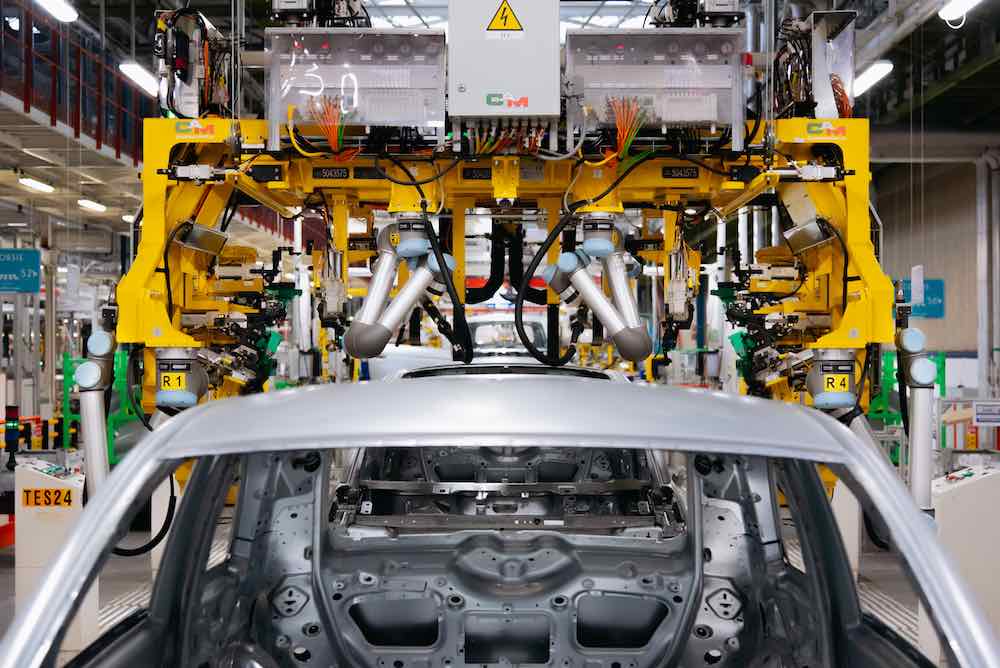
Stellantis N.V. is a Dutch multinational automobile manufacturer established through a merger between PSA and Fiat Chrysler Automobiles. The company installed 11 collaborative robot arms from Universal Robots (UR) at its Mirafiori factory in Turin, Italy, to automate a series of complex assembly line operations and quality controls for the new Fiat 500 electric car.
The collaborative applications developed at Mirafiori have delivered significant benefits in terms of operating precision and quality, and also improved the ergonomics of a series of operations previously performed manually.
Challenge
On the Fiat 500 electric car production line, some of the assembly processes and quality controls required the introduction of specific automation technologies to ensure the quality and repeatability needed to meet product standards. Additionally, given the fairly high average age of the factory workers, the question of ergonomic well-being was also an issue.
Solution
Stellantis decided to adopt UR cobots robots some years ago. Collaborative automation has freed operators from repetitive and physically demanding manual tasks, so that they can be employed on processes with greater added value.
The 11 UR cobots now automate the following applications:
- Application of the waterproof liner to the vehicle doors (2 UR10e cobots working in parallel)
- Positioning of the soft-top (activation of the primer track and visual inspection to ensure the correct extrusion of the adhesive band around the perimeter) (1 UR10e)
- Check on soft-top frame dimensions (1 UR10e)
- Riveting of the tailgate with blind rivets press-set on the boot frame (1 UR10e)
- Hood mounting (1 UR10)
- Tightening of the rear side-door hinges (1 UR10)
- Mudguard mounting (2 UR5 and 2 UR10 cobots)
The UR cobots at the Mirafiori factory were rolled out gradually to enable the operators to fully understand how the automated processes worked.
“As a first step, we decided to introduce a UR cobot in the company canteen, distributing glasses of water to employees during the lunch break,” Mirafiori plant manager Luigi Barbieri said. “This gave the line workers the opportunity to see the safety and collaborative nature of the cobots for themselves, and overcome any apprehensions about the safety of the subsequent applications.”
Results
After the success of this initial trial, the UR cobots were installed on a series of applications on the 500 electric car production line:
Application of the waterproof liner to the vehicle doors: Two UR10e cobots operate in parallel on the door assembly line. A vision system registers the arrival of the door and activates the cobot, which uses a roller attached to its wrist to apply constant pressure on the fabric, applying it on the door panel.
The application is particularly challenging because it requires the cobot to follow a complex path within a confined space, avoiding the panel’s push pin protrusions and ensuring that the liner is completely sealed to prevent the infiltration of water. The cobots work with millimetric precision, guaranteeing a repeatability of +/- 0.05 mm.
“The UR cobot has significantly improved the ergonomics of this application,” said ergonomics specialist Giuseppe Guidone. “The application of the liner required the operator to apply constant pressure using a dynamometric roller, a task that over the long term could damage the arm joints and cause musculoskeletal disease. So the cobot has brought two benefits: high operating precision and quality, along with improved ergonomics and well-being for our operators.”
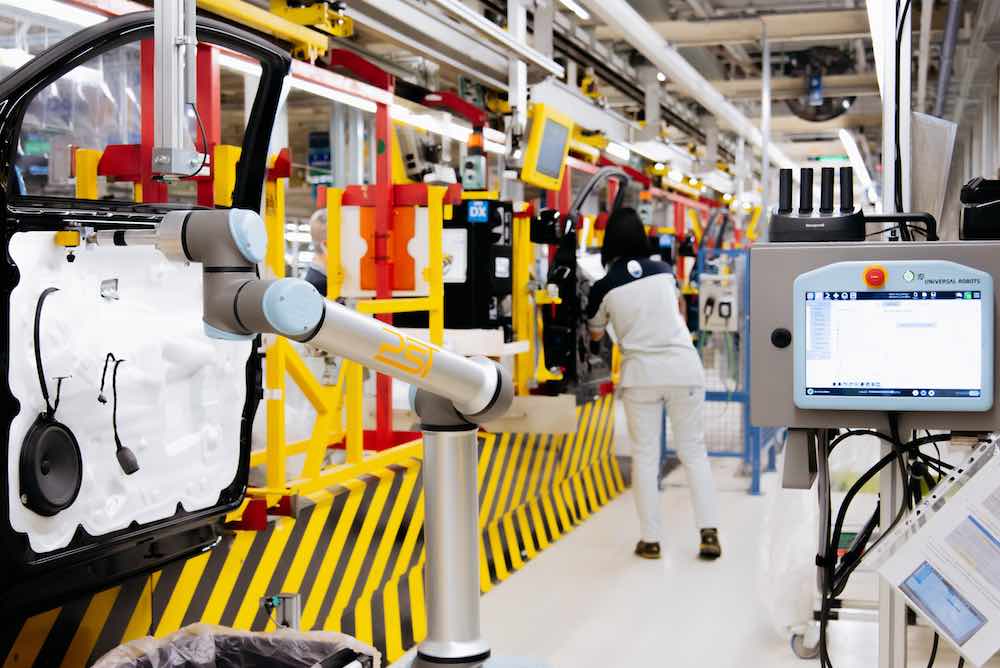
A UR10e cobot uses a roller attached to its wrist to apply the fabric to the door panel. | Credit: Universal Robots
Soft-top assembly
Two UR10e cobots operate on the soft-top assembly line for the Fiat cabrio 500 model. The first cobot performs two different operations; Using a pad supported by a special pick-up device, the UR10e cleans and prepares the primer track, on which the adhesive to fix the soft-top to the frame is subsequently applied. The second operation is a quality control, where a vision system checks the geometric continuity and dimensions of the adhesive band. The second cobot works in synergy with an anthropomorphic robot.
Once the soft-top has been assembled, it is opened on a special support and then picked up by the robot. At this point, the second UR cobot runs a size check (through a vision system) on the soft-top frame to ensure the conformity of the dimensions. Once conformity has been ascertained, the soft-top is removed from the line by the anthropomorphic robot.
This application offers a series of productivity and quality advantages. The cobots ensure that the adhesive extrusion is correct and check the dimensions of the soft-top frame.
Tailgate riveting
On the door assembly line for the Fiat 500 electric car, a UR10e cobot has been configured to press-set 10 blind pop rivets, which secure the boot hinge reinforcements to the boot frame. The operator loads the tailgate frame and hinge reinforcements onto the workstation, then leaves the cobot to position and press-set the rivets.
The application provides productivity and ergonomic benefits. At the same time, constant monitoring of the workstation input and output parameters ensures higher and consistent process quality.
Hood mounting
For this application, the car body reaches the workstation with the hood mounted in a closed position and the hinge screws inserted by the operators on the previous station. Once the hood geometry has been established, the cobot (a UR10) moves into position and tightens the 4 screws to the correct torque.
The main advantages of this application are quality, efficiency and ergonomics, given that the hood reaches the station in a closed position, making correct tightening extremely difficult. Since the hinge screws to be tightened are not visible, the operator could easily miss one or make an incorrect tightening. The cobot also improves the ergonomics of the operation, freeing the operators from working in uncomfortable or awkward positions.
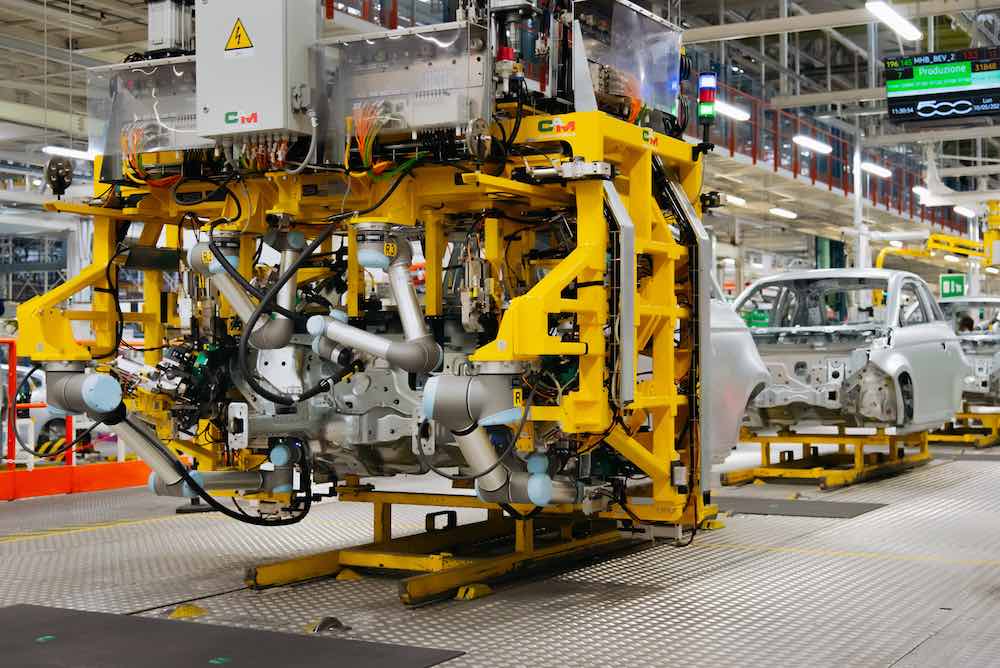
Two UR5 and two UR10s cobots are installed on a platform that lowers itself on
the z axis in relation to the body. The wings of the platform close to fix the geometry and
activate the tightening operation on the 24 screws that fasten the mudguards. | Credit: Universal Robots
Extra door hinge tightening
For the Fiat 500 model featuring an extra rear side door, an automated application capable of performing a complex tightening cycle was required. With the assistance of an advanced automated tool on which the cobot is installed, the door is positioned correctly on the vehicle body. The cobot then performs the tightening operations, from the rear of the boot.
The cobot meets two different process requirements: it frees the operator from tightening the hinges in an awkward posture, where they would be unable to see the correct positions inside the car body; and it prevents the kickback from the tightening tool (which operates with a 75 Nm torque) hitting the arm of the operator.
Mudguard mounting
In this station on the sheet metal line, the frame arrives with the right and left mudguards already in position. Two UR5 and two UR10s cobots are installed on a platform that lowers itself on the z axis in relation to the body. The wings of the platform close to fix the geometry and activate the tightening operation on the 24 screws that fasten the mudguards. Each of the 4 cobots is fitted with an automatic screw gun with torque control.
The application offers various advantages. Collaborative automation guarantees ergonomic benefits for the operators (who are no longer required to work below the vehicle body). Since the screws are torque tightened, tensile stress on the sheet metal parts is eliminated. Also, the cycle time is shortened, boosting the productivity of the whole station.
The post How 11 cobots help assemble the Fiat 500 electric car appeared first on The Robot Report.




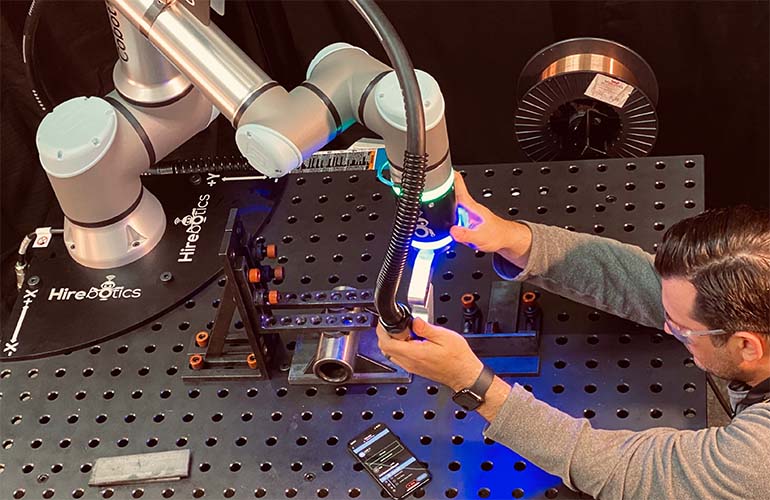
 , and includes everything necessary to quickly deploy a robotic welding station in your facility. Hirebotics developed a unique smartphone-based welding application that reduces the time to get it going and makes it easy to operate by staff without a robotics background. The use of state-of-the-art collaborative robotic manipulators means that the equipment doesn’t require the same fixed guarding as industrial robot manipulators.
, and includes everything necessary to quickly deploy a robotic welding station in your facility. Hirebotics developed a unique smartphone-based welding application that reduces the time to get it going and makes it easy to operate by staff without a robotics background. The use of state-of-the-art collaborative robotic manipulators means that the equipment doesn’t require the same fixed guarding as industrial robot manipulators.